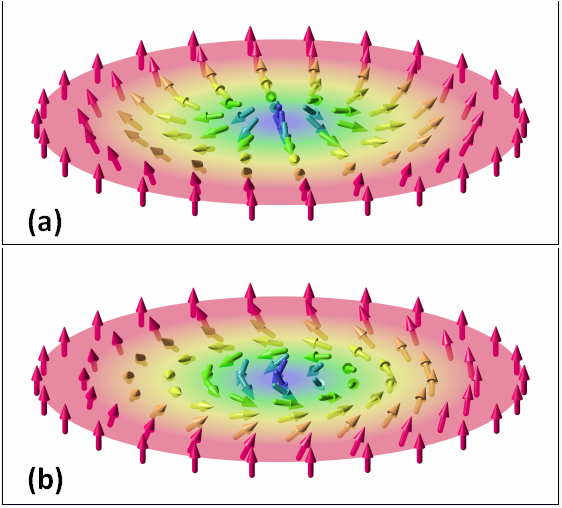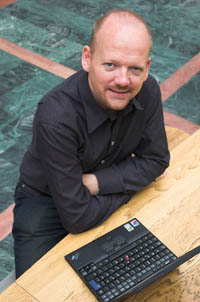R&D: Method for Dynamic, Stable Skyrmions
Step forward for future of storage
This is a Press Release edited by StorageNewsletter.com on October 19, 2015 at 3:30 pmBy David Callahan
A KTH researcher is part of an international team that has unlocked the secret to creating stable dynamic skyrmions – the nanoscale magnetic whirls that promise to meet our insatiable appetite for data storage.
The vector field of two, two-dimensional magnetic skyrmions.
(Image: Karin Everschor-Sitte and Matthias Sitte (The Authors) [CC BY-SA 3.0
(http://creativecommons.org/licenses/by-sa/3.0)], via Wikimedia Commons)
The future of data storage is likely to be found in nanometer scale, stable magnetic whirls called skyrmions, which behave like particles in magnetic thin films. But creating these whirls has been notoriously difficult, requiring carefully-engineered multilayers or very specific bulk materials.
However, recent research published in Nature Communication (see below) could change that. Johan Åkerman, a renowned spintronics researcher and a guest professor at KTH Royal Institute of Technology who co-led the study, says that the research enables an entirely new range of materials where skyrmions can be observed.
Johan Åkerman, renowned spintronics researcher
and a guest professor at Stockholm’s KTH
Royal Institute of Technology, co-led the study.
“Since there is an insatiable appetite for storing information, for uses such as mobile phones, computers, and particularly online, nano-skyrmions are very interesting as an information carrier,” Åkerman says. “They can be made extremely small and are easily programmed using spin-polarized currents like in MRAM (magnetoresistive random-access memory).”
The team showed that a magnetic skyrmion can be created under a nanocontact, in which a spin-polarized current is injected into the magnetic thin film providing a so-called spin torque to its magnetic moments. For sufficiently large currents, this setup will allow the creation of a skyrmion of 10-20 nanometers in size, underneath the nanocontact.
A skyrmions can also be stabilized by the spinning motion around its own axis, in a way that’s similar to how a top stabilizes itself. Once created, they can be transported over distances of several hundreds nanometers, which means that skyrmions can be created and manipulated in materials that have never before been considered for skyrmionics.
In using the spin-polarized currents, the study recalls Åkerman’s discovery of a spin torque-generated nano-droplet in 2013.
“We have also shown that the dynamic skyrmions can generate much stronger output in spintronic oscillators, so the potential use for this new phenomenon is great,” he says.
The study also involved researchers at University of Gothenburg (Sweden), University of Hong Kong (China), and University College Dublin (Ireland).
Article reference:
Nature Communications has published the article written by Y. Zhou, York-Nanjing Joint Center for Spintronics and Nano Engineering (YNJC), School of Electronics Science and Engineering, Nanjing University, Nanjing 210093, China, and Department of Physics, The University of Hong Kong, Hong Kong, China, E. Iacocca, A. A. Awad, R. K. Dumas, Department of Physics, University of Gothenburg, 412 96 Gothenburg, Sweden, F. C. Zhang, Department of Physics, The University of Hong Kong, Hong Kong, China, Department of Physics, Zhejiang University, Hang Zhou 310027, China, and Collaborative Innovation Center of Advanced Microstructures, Nanjing, China, H. B. Braun, UCD School of Physics, University College Dublin, Dublin 4, Ireland, and Theoretical Physics and Department of Materials, ETH Zürich, CH-8093 Zürich, Switzerland, and J. Åkerman, Department of Physics, University of Gothenburg, 412 96 Gothenburg, Sweden, and Materials and Nano Physics, School of ICT, KTH Royal Institute of Technology, Electrum 229, 164 40 Kista, Sweden.
Panels (a–e) show skyrmions with skyrmion number S=1.
(a) A bubble skyrmion stabilized by dipolar interactions which may exist as a left- or
right-handed version. Its size typically exceeds that of skyrmions stabilized by DMI. (b,c)
DMI stabilized skyrmions: (b) A chiral skyrmion as favoured in B20-type materials such
as MnSi. (c) A hedgehog skyrmion as favoured by interfacial DMI.
Note that in both cases the domain-wall chirality when passing through the
skyrmion centre is fixed by the DMI and not degenerate as in a.
(d) Dynamically stabilized magnetic skyrmion which requires neither dipolar
interactions nor DMI and which exhibits precession around the (vertical)
easy-axis anisotropy. During precession, the skyrmion number is strictly
conserved and the skyrmion sweeps across all possible chiral and
hedgehog configurations. In the presence of either dipolar interactions,
DMI, or an Oersted (Oe) field, the skyrmion diameter varies periodically
in time (breathing). (e) For vanishing dipolar interactions (DDI),
DMI and Oe fields, and in absence of damping, the skyrmion precesses uniformly
and breathing disappears. Note that panel e only shows half a period
of the precessional motion to emphasize that both chiral and hedgehog
configurations are being covered in the DS states.
Abstract : “Magnetic skyrmions are topologically non-trivial spin textures that manifest themselves as quasiparticles in ferromagnetic thin films or noncentrosymmetric bulk materials. So far attention has focused on skyrmions stabilized either by the Dzyaloshinskii–Moriya interaction (DMI) or by dipolar interaction, where in the latter case the excitations are known as bubble skyrmions. Here we demonstrate the existence of a dynamically stabilized skyrmion, which exists even when dipolar interactions and DMI are absent. We establish how such dynamic skyrmions can be nucleated, sustained and manipulated in an effectively lossless medium under a nanocontact. As quasiparticles, they can be transported between two nanocontacts in a nanowire, even in complete absence of DMI. Conversely, in the presence of DMI, we observe that the dynamical skyrmion experiences strong breathing. All of this points towards a wide range of skyrmion manipulation, which can be studied in a much wider class of materials than considered so far.“
Read also: NIST and UC Davis Scientists Float New Approach to Creating Computer Memory

















 Subscribe to our free daily newsletter
Subscribe to our free daily newsletter

